Table of Contents
ToggleIn an era of hyper-competition, accelerating digital disruption, global uncertainty, and evolving customer expectations, large organizations can no longer rely solely on hierarchical planning, rigid processes, or slow decision cycles. They must become agile organizations: structures that can respond, adapt, pivot, and innovate continuously. That shift is not optional — it’s fundamental to survival and growth.
In this article, we explore in depth why organizational agility is important, grounded in research and real-world transformation practices. We also show how agile transformation consultancies help deliver the shift, and what leaders in large organizations must focus on to succeed.
What Do We Mean by “Organizational Agility”?
Before we dive deeper, let’s align on definitions.
- Business Agility / Organizational Agility is not just about teams doing Scrum or cycles of sprints. According to Scrum Alliance, business agility is a company’s collective ability to adapt and respond rapidly to changing market conditions, delivering value sustainably while managing risk. scrumalliance.org
- It means shifting from project-centric, plan-driven thinking to value streams, continuous feedback, decentralised decision-making, and emergent learning.
- As Scrum.org notes, “Organizational Agility refers to the ability of the organization to respond predictably to customers’ changing needs … it’s not always about speed; it’s about the ability to change in tandem with or ahead of changing market conditions.” Scrum.org
- Achieving agility at scale often means adopting frameworks like Scrum@Scale, SAFe, LeSS, Nexus, or evolving your own adaptive operating model. For example, Scrum@Scale extends scrum across the ecosystem of teams using minimal bureaucracy. atlassian.com
In short: agility is about turning your entire enterprise into a responsive, adaptive organism — not just pockets of agile teams.
Why Big Organizations Need Organizational Agility
Let’s explore the compelling drivers for why large enterprises must invest in agility. Each point is backed by research or industry evidence.
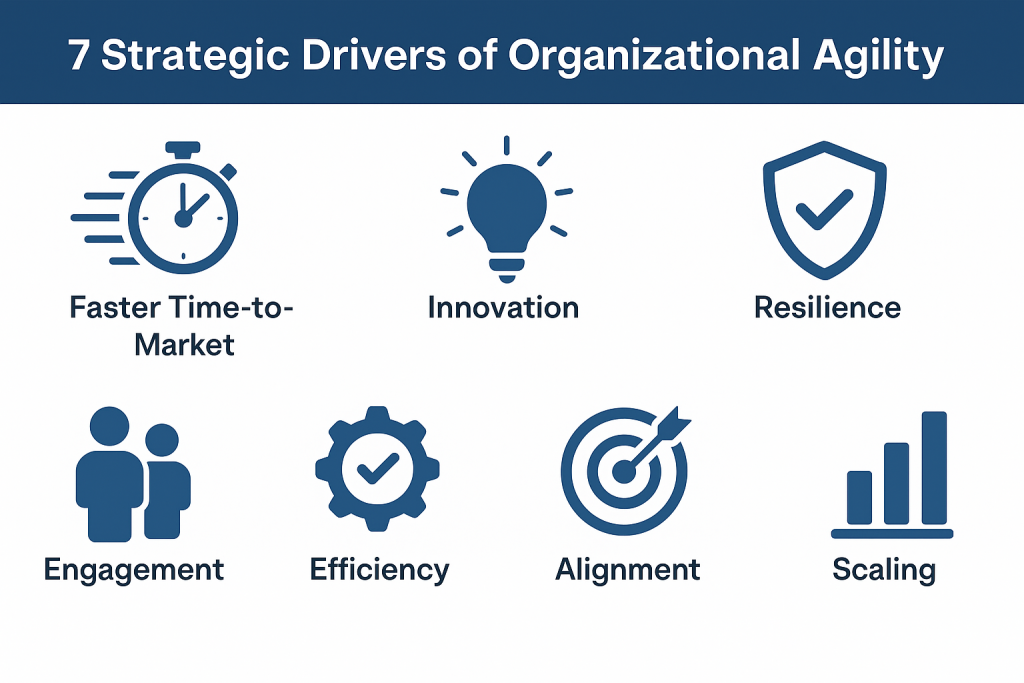
1. Faster Time-to-Market & Increased Responsiveness
Large organizations that have adopted greater agility consistently report accelerated time-to-market. According to a joint report by Scrum Alliance and Forbes Insights, organizations that achieved higher agility saw faster innovation, quicker product release, improved revenue growth, and higher employee morale. resources.scrumalliance.org
McKinsey’s research confirms this: agility has moved from theory to practical advantage, enabling firms to outperform less flexible peers. McKinsey & Company
Moreover, Scrum Alliance outlines how agility helps organizations reduce risk by surfacing issues earlier, enabling smaller mistakes and faster course corrections. scrumalliance.org
For large organizations, this means shorter innovation cycles, more frequent customer feedback loops, and the capacity to respond to shifting market signals faster than monolithic competitors.
2. Innovation & Competitive Edge
Organizational agility fosters an environment of continuous experimentation and learning. Empirical research supports a direct link:
- In Agility and Innovativeness: The Serial Mediating Role, Park et al. (2022) show that agility positively influences innovativeness via mediators like knowledge sharing and absorptive capacity. PMC
- Another study, Impact of Agile Learning on Innovative Behavior, finds that learning agility (an individual-level correlate) strongly links to employee engagement and innovative actions. PMC
In a large enterprise, this implies being able to launch new products, business models, or services more rapidly — and to iterate them fast based on real feedback rather than fixed plans.
3. Organizational Resilience in Uncertainty
Volatility, uncertainty, complexity, and ambiguity (VUCA) are now the norm, not the exception. The ability to sense and respond becomes a core competitive capability.
Large firms often suffer from inertia, legacy systems, departmental silos, and hierarchical bottlenecks. Organizational agility helps mitigate those:
- By distributing decision-making closer to the frontline
- By promoting cross-functional collaboration
- By embracing emergent strategy over rigid long-term plans
- By enabling adaptation to external disruptions (pandemics, regulatory shifts, competitor moves)
4. Employee Engagement, Retention & Culture
Agile organizations invest in empowering teams, encouraging autonomy, feedback loops, and transparency. That helps drive higher morale, ownership, and innovation mindset.
In the Forbes–Scrum Alliance survey, 81% of executives considered agility the most important characteristic of a successful organization. Forbes
Additionally, Scrum Alliance’s articles on agile skills note that agile competencies (e.g. adaptability, collaboration, learning mindset) are in growing demand, and organizations that embed agility into roles and culture are more sustainable. resources.scrumalliance.org
Thus, agility helps in not just project performance, but in building a culture attractive to top talent.
5. Efficiency, Waste Reduction & Cost Control
Agile approaches eliminate waste, improve flow, reduce hand-offs, and enable incremental delivery (thus reducing rework). That is classic Lean thinking, integrated into agile delivery.
Large organizations often carry heavy overheads and bureaucratic frictions. Becoming agile allows them to flatten structure, remove unnecessary gatekeeping, streamline governance, and reduce cost and risk.
For instance, in surveys, many organizations report that while they excel at recognizing opportunities, they struggle to execute decisively (i.e. the gap is not in vision, but in operational agility).
6. Strategic Alignment & Coherence Across Silos
In big firms, different business units, functions (HR, finance, operations, R&D) often operate in silos. Organizational agility helps bridge alignment and coherence:
- Value stream thinking aligns across functions
- Shared objectives (e.g. OKRs) unify direction
- Agile governance models help manage dependencies
- Systems-level design thinking ensures the whole is greater than sum of parts agilealliance.org
7. Enable Scaling Without Chaos
If your organization has multiple agile teams, scaling agility is essential to avoid fragmentation, disconnects, and chaos. Frameworks like Scrum@Scale provide scale-free architecture to coordinate multiple teams without excessive overhead. atlassian.com
Large organizations that adopt a patchwork of independent agile pockets risk inconsistency, duplication, and governance gaps.
Research & Empirical Evidence: What Studies Tell Us
To make your blog more credible and persuasive, here’s a selection of empirical findings and surveys:
| Study / Source | Key Finding / Insight | Implication for Big Organizations |
|---|---|---|
| Design of Transformation Initiatives Implementing Organisational Agility (Kovynyov et al.) | Surveyed 125 organizations across Europe; found holistic approach (culture, leadership, process) correlates with higher agility. arXiv | Transformations can’t just be about IT or development — every function needs to shift. |
| Group development and group maturity | Agility of teams correlates with group maturity levels. arXiv | Teams need investment in group development, not just mechanics. |
| Forbes–Scrum Alliance executive survey | 81% of executives see agility as key; agile transformations led to revenue growth, faster time-to-market. Forbes+1 | The executive belief is strong — use this as a business lever. |
| Scrum.org / Scrum Master role in org agility | The Scrum Master must transcend team-level boundaries and contribute to systemic agility. Scrum.org | Roles must evolve; agility can’t be contained within “IT.” |
| Agile governance literature (systematic review) | Agile governance is emergent, multidisciplinary, enabling flexibility while preserving accountability. arXiv | Governance models must shift — not abandon controls, but make them adaptive. |
Taken together, these studies reinforce that agility at enterprise scale is a system-level endeavor, and that ad hoc adoption without holistic transformation tends to stall.
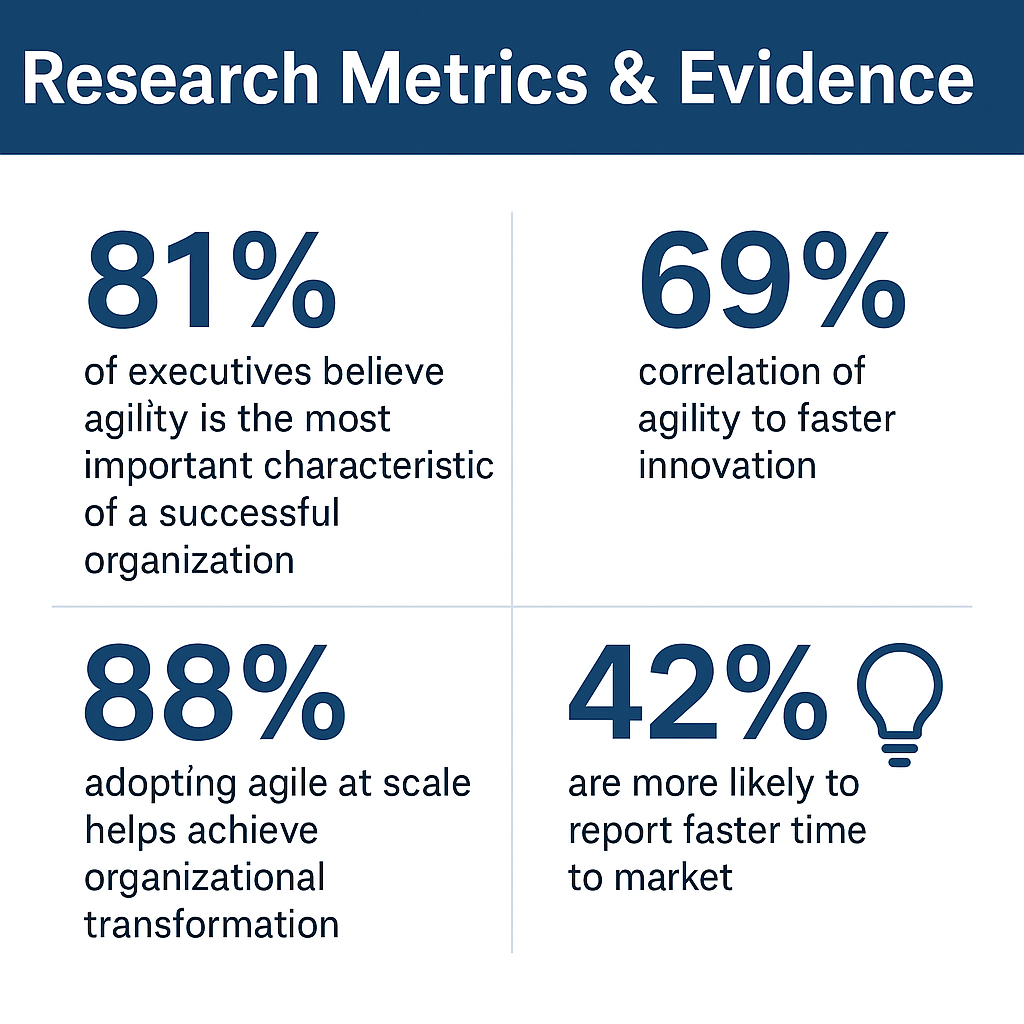
Role of Agile Transformation Consultancies
Large organizations often partner with specialized consultancies to manage the complexity of enterprise agility transformation. Here’s what they bring (and what you should expect):
1. Diagnostic & Readiness Assessment
Consultancies conduct maturity assessments across dimensions (culture, leadership, structure, technology) to establish a baseline and roadmap.
2. Co-creation of Transformation Strategy
Rather than dictating, good consultancies co-create with leadership, aligning transformation to strategic goals, identifying value streams, and selecting suitable scaling models (SAFe, LeSS, Scrum@Scale, custom).
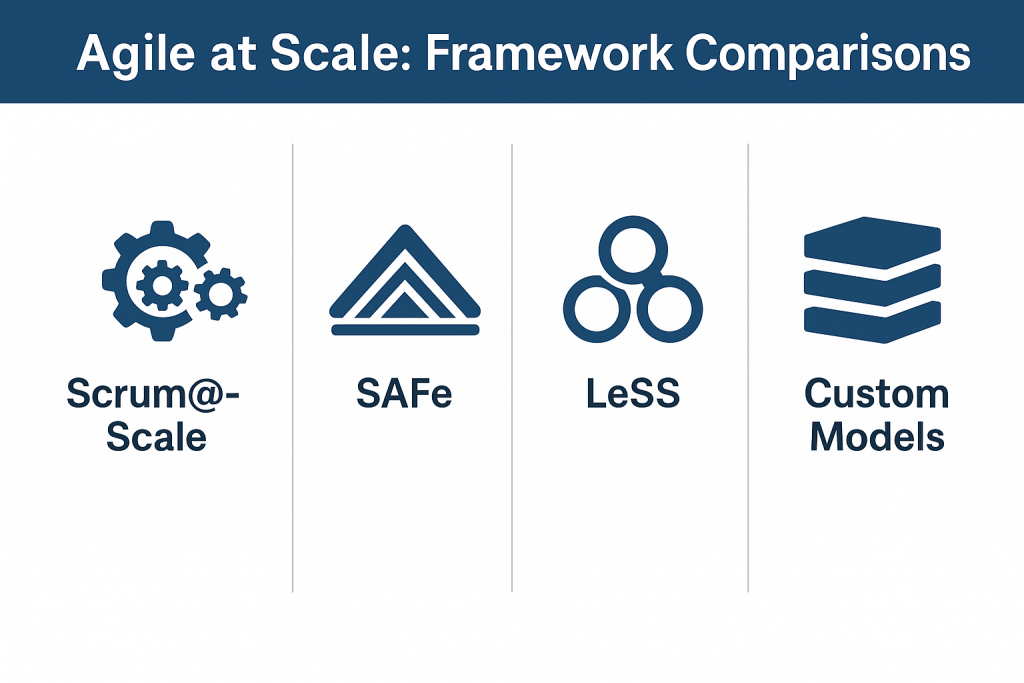
3. Coaching & Capability Building
They deploy coaches at multiple levels (executive, portfolio, team) to transfer skills, embed thinking, facilitate change, and help leaders internalize agile mindset.
4. Change Management & Culture Shift
One of the hardest parts is cultural and mindset shift. Consultancies help with stakeholder alignment, communication plans, incentives, behavior reinforcement, and addressing resistance.
5. Structure & Governance Design
They assist in designing new operating models, governance layers, metrics, decision rights, and integrating agile budgeting, HR, and performance systems.
6. Pilot Runs, Scaling, and Continuous Feedback
They often begin with pilots (value stream or domain), measure, learn, adapt, then scale in waves — always using feedback cycles to course-correct.
7. Sustainability & Continuous Improvement
Consultants aim to build internal capability (agile COEs, communities of practice, internal coaches) so that the transformation becomes self-sustaining.
Many consultancies publish case studies demonstrating that organizations undergoing guided transformation see improvements in delivery speed, quality, employee satisfaction, and financial results.
Key caution: consultancies are enablers — the organization must own the change. Without sustained executive backing and internal change leadership, transformations often stall.
How Large Organizations Should Think About Their Agility Journey
Here’s a recommended structure / blueprint for large organizations aspiring to become agile at scale.
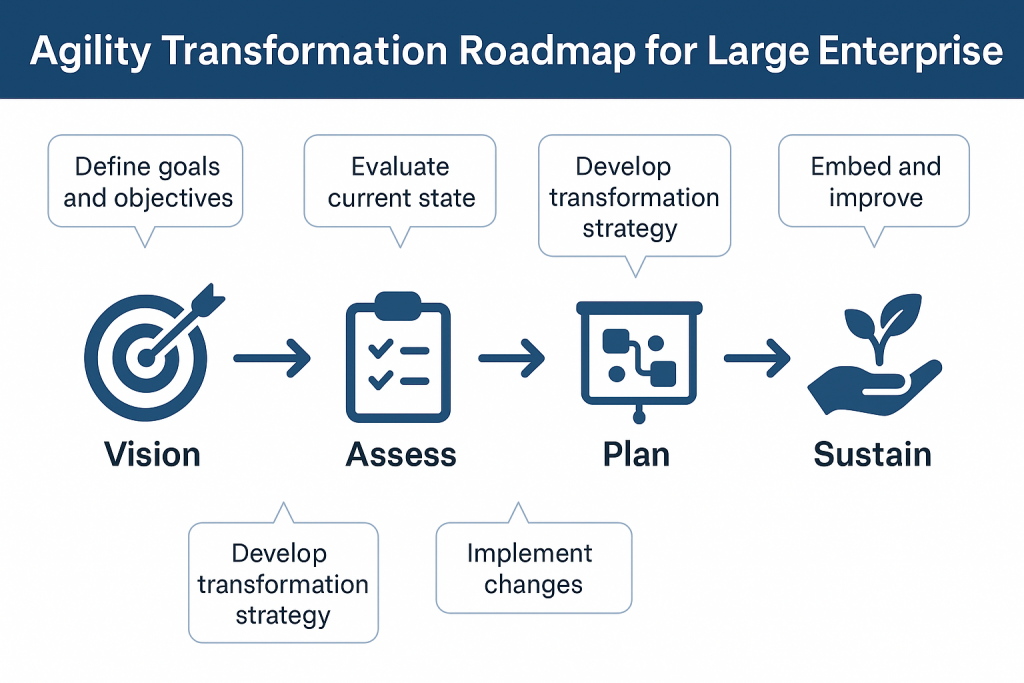
Phase 1: Executive Alignment & Vision
- Secure executive sponsorship and mandate
- Define the “north star” vision for agility (Why? What outcomes?)
- Create change coalition and transformation leadership team
Phase 2: Assess & Map Value Streams
- Conduct agile maturity / readiness assessments
- Map end-to-end value streams (cross-functional)
- Identify bottlenecks, dependencies, and friction
Phase 3: Pilot / Proof-of-Concept
- Choose one value stream, domain, or business unit as pilot
- Define minimal viable operating model (teams, governance, roles)
- Launch cross-functional teams, embed feedback loops
Phase 4: Expand & Scale
- Use lessons from pilot to scale to adjacent value streams
- Introduce scaling frameworks or custom governance
- Ensure alignment across business, IT, HR, finance
Phase 5: Embed Culture, Metrics & Continuous Learning
- Introduce OKRs, lean metrics, cadence reviews
- Put in place communities of practice, internal coaching, knowledge-sharing
- Evolve systems (HR, performance, budgeting) to supports agility
Phase 6: Sustain & Evolve
- Continuously inspect and adapt the transformation
- Monitor lagging/leading indicators
- Refresh leadership, evolve models, resist dogma
Common Pitfalls & How to Avoid Them
- “Doing Agile” rather than “Being Agile” — merely adopting rituals (standups, sprints) without cultural shift leads to superficial change. Agile Alliance emphasizes design thinking and systems modeling to optimize the whole. agilealliance.org
- Overcentralization vs. no control — some organizations swing the pendulum too far; agile governance must balance autonomy with accountability.
- Insufficient executive engagement — transformations stall when leaders revert to command-and-control.
- Neglecting non-IT functions — HR, finance, legal, operations must also adapt or become blockers.
- Lack of patience or unrealistic expectations — agility is a long-term journey, not a flip-the-switch change.
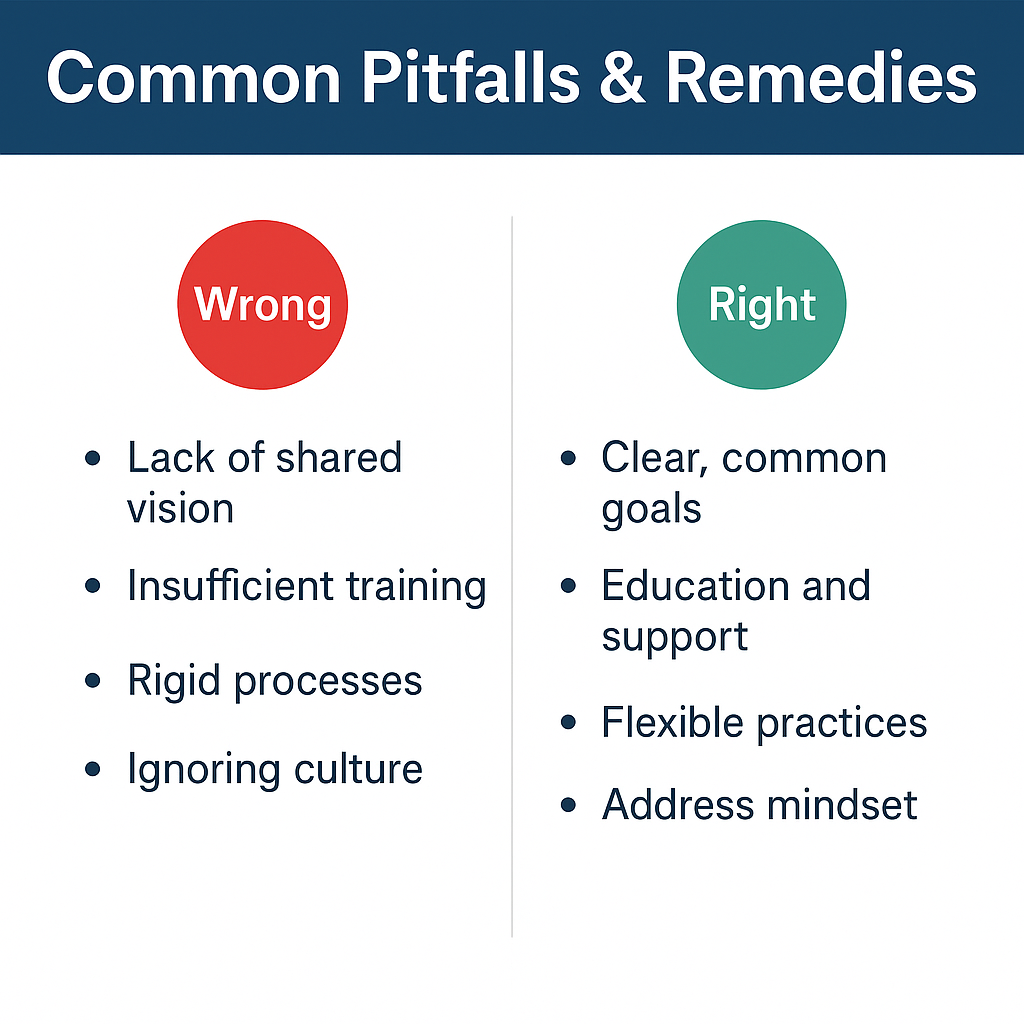
For large, complex organizations, organizational agility is no longer an optional methodology choice—it is a strategic imperative. Agility is your competitive edge in a world where customer preferences shift overnight, technologies evolve rapidly, and disruption can come from unexpected corners.
But achieving enterprise agility is difficult. It requires more than training a few teams. It demands holistic transformation: culture, structure, leadership, governance, metrics, and technical systems must all evolve harmoniously.
A well-led, well-coached agile transformation can equip your organization to deliver faster, sustain innovation, delight customers, and build a resilient, engaged workforce.
